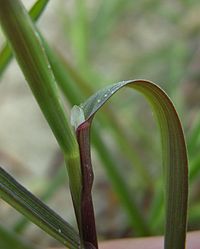Agrostis stolonifera
| Agrostis stolonifera | |
|---|---|

| |
| Scientific classification | |
| Kingdom: | Plantae |
| Clade: | Tracheophytes |
| Clade: | Angiosperms |
| Clade: | Monocots |
| Clade: | Commelinids |
| Order: | Poales |
| Family: | Poaceae |
| Subfamily: | Pooideae |
| Genus: | Agrostis |
| Species: | A. stolonifera
|
| Binomial name | |
| Agrostis stolonifera L., 1753
| |
| Synonyms[3] | |
|
List
| |
Agrostis stolonifera (creeping bentgrass, creeping bent, fiorin, spreading bent or carpet bentgrass[3][4][5]) is a perennial grass species in the family Poaceae. It is widely used as turf for golf courses.[6]
Description
[edit]Agrostis stolonifera is stoloniferous and may form mats or tufts. The prostrate stems of this species grow to 0.4–1.0 metre (1 ft 4 in – 3 ft 3 in) long with 2–10-centimetre (0.79–3.94 in) long leaf blades and a panicle reaching up to 40 cm (16 in) in height.
The ligule is pointed and up to 5 millimetres (0.20 in) long. This differs from common bent, Agrostis capillaris, which is short and does not come to a point.
The leaves are tapering, often with a blue-grey colour. The grass is not tufted and the spikelets are red and tightly closed within the panicle.[7] It flowers in July and August.


Distribution
[edit]It can be found growing in a variety of habitats including woodlands, grasslands and meadows, wetlands, riparian zones, and as a pioneer species on disturbed sites.[5] It is native to Eurasia and North Africa (Algeria, Morocco and Tunisia). It is possible that it may also be native to northern parts of North America, and in any case it has been widely introduced and naturalised on that continent and in many other places.[4]
It is a constituent of wet habitats such as marshy grasslands. Some of its species[clarification needed]have adapted to contaminated conditions and can cope with heavy metals. It can exist up to 2,500 feet (760 m).[8]
Cultivation
[edit]It is the most commonly used species of Agrostis.[9]
It is used for turf in gardens and landscapes, particularly on golf courses.[5] Many of the putting greens as well as an increasing number of fairways in the northern USA are creeping bentgrass.
Transgenic varieties
[edit]In the 1990s, Scotts Miracle-Gro and Monsanto led early work in creeping bentgrass transgenics looked at glyphosate-resistance. However, due to easy wind pollination, seeds were accidentally dispersed from an experimental farm in Oregon in 2003. Scotts Miracle-Gro was fined $500,000 as a result.[10] In 2017, the USDA agreed not to regulate it at Scotts request, which meant that Scotts "will no longer be legally required to pay to clean up the grass after 2017, though it has promised to do so."[11] A 2004 gene flow study (with scientific sampling methods) documents gene flow on a landscape level, with a maximum at 21 kilometres (13 mi) and 14 km (8.7 mi) (respectively) in sentinel and resident plants observed by scientist, located in primarily nonagronomic places such as irrigation ditches.[12]
Other work in transgenic bentgrass looks into salinity tolerance. The improved performance of the transgenic plants was associated with higher relative water content, higher sodium uptake and lower solute leakage in leaf tissues, with higher concentrations of Na+, K+, Cl- and total phosphorus in root tissues, and with higher auxin accumulation rate in the root tissue. This transgenic plant can survive in the presence of 1.7% sodium chloride (half seawater salinity concentration), while the non transgenic line and wild type plants cannot.[13]
References
[edit]- ^ Lansdown, R.V. (2014). "Agrostis stolonifera". IUCN Red List of Threatened Species. 2014: e.T164020A42383133. doi:10.2305/IUCN.UK.2014-1.RLTS.T164020A42383133.en. Retrieved 19 November 2021.
- ^ NatureServe. "Agrostis stolonifera". NatureServe Explorer. Arlington, Virginia. Retrieved 10 December 2024.
- ^ a b NRCS. "Agrostis stolonifera". PLANTS Database. United States Department of Agriculture (USDA). Retrieved 2010-03-16.
- ^ a b "Agrostis stolonifera". Germplasm Resources Information Network. Agricultural Research Service, United States Department of Agriculture. Retrieved 2010-03-16.
- ^ a b c Esser, Lora L. (1994). "Agrostis stolonifera". Fire Effects Information System (FEIS). US Department of Agriculture (USDA), Forest Service (USFS), Rocky Mountain Research Station, Fire Sciences Laboratory. Retrieved 2010-03-16.
- ^ Elmore, Matthew T.; Brosnan, James T.; Armel, Gregory R.; Vargas, Jose J.; Breeden, Gregory K. (2015). "Influence of Herbicide Safeners on Creeping Bentgrass ( Agrostis stolonifera ) Tolerance to Herbicides". Weed Technology. 29 (3): 550–560. doi:10.1614/WT-D-14-00045.1. S2CID 86197665.
- ^ BSBI Description Archived 2011-07-17 at the Wayback Machine retrieved 2010-11-16.
- ^ C. E. Hubbard (1978). Grasses. Penguin Books. ISBN 9780140132274.
- ^ L. Watson; M. J. Dallwitz (2008). "The grass genera of the world: descriptions, illustrations, identification, and information retrieval; including synonyms, morphology, anatomy, physiology, phytochemistry, cytology, classification, pathogens, world and local distribution, and references". The Grass Genera of the World. Archived from the original on 2008-07-24. Retrieved 2009-08-19.
- ^ Notarianni, John (July 21, 2018). "How A Botched Experiment Sent GMO Grass Creeping Across Oregon". OPB. Retrieved 29 November 2022.
- ^ Main, Douglas (January 17, 2017). "USDA Agrees to Not Regulate Genetically Modified Grass On the Loose In Oregon". Retrieved 29 November 2022.
- ^ Lidia S. Watrud; E. Henry Lee; Anne Fairbrother; Connie Burdick; Jay R. Reichman; Mike Bollman; Marjorie Storm; George King & Peter K. Van de Water (2004). "Evidence for landscape-level, pollen-mediated gene flow from genetically modified creeping bentgrass with CP4 EPSPS as a marker". Proceedings of the National Academy of Sciences. 101 (40): 14533–14538. Bibcode:2004PNAS..10114533W. doi:10.1073/pnas.0405154101. PMC 521937. PMID 15448206.
- ^ ZHIGANG LI, Christian M. Baldwin, Qian Hu, Haibo Liu, Hong Luo (2010). Heterologous Expression of Arabidopsis H+-PPase Enhances Salt Tolerance in Transgenic Creeping Bentgrass (Agrostis stolonifera L.). Plant, Cell and Environ, Volume 33 Issue 2, P. 272–289.


